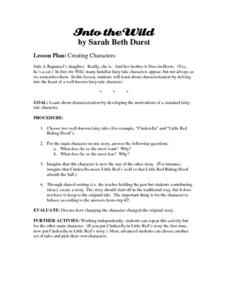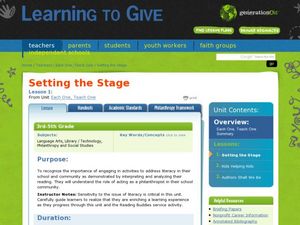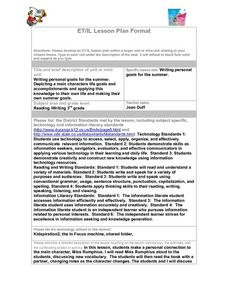Curated OER
Into the Wild: Creating Characters
Students analyze well-known fairy tale characters to learn about characterization. After choosing two fairy tale characters and determining what the characters most want and most fear, students switch characters and stories. They...
Curated OER
Setting the Stage
Students investigate the importance of literacy to philanthropy. In this literacy lesson, students read the book, Amber on the Mountain, before answering questions about the main character's motives for learning to read. They make charts...
Curated OER
Story Elements
Third graders identify story elements. In this story elements lesson, 3rd graders look at main idea, characters, point of view, theme and setting. They create a five paneled comic strip from a book.
Curated OER
Stump the Dump Maze Game
Students complete reading Because of Winn-Dixie individually or as a class. As students reunite Opal and Winn-Dixie in this timed reading comprehension maze game, they demonstrate their understanding of the novel's plot, theme, and...
Curated OER
Essential Narrative Concepts
Students interact with the main concepts of a narrative text in the six lessons of this unit. The setting, prediction, retelling, sequencing, and the identification of the beggining, middle and end of a story are investigated.
Houghton Mifflin Harcourt
Core Analysis Frame: Fiction
Dig into any piece of fiction with a series of analysis questions. There are two levels of questions provided: basic and in-depth. The basic questions can be copied double-sided onto a single piece of paper, while the in-depth questions...
Freeology
Summarizing
Scholars draft a summary using a graphic organizer featuring a story's characters, setting, main events, conflict, and resolution.
Florida Center for Reading Research
Comprehension: Narrative Text Structure, Story Pieces
An activity boosts reading comprehension by challenging scholars to answer questions about a narrative tale detailing elements—plot, characters, setting, theme, problem, and solution.
Curated OER
Create a Playbill!
Seventh graders explore the various elements found in the advertisement of a dramatic experience. Playbills are created that reflect the plot without revealing the climax of the play. Costumes, set construction, and character description...
Maine Content Literacy Project
Introduction to Ernest Hemingway
What is a white elephant, and what does it have to do with Ernest Hemingway? Study "Hills Like White Elephants" in-depth by following the procedures outlined in this lesson, the fifth in a series of fourteen. Learners start the day with...
Curated OER
Introducing Literary Elements in Fiction
Identify literary elements in fiction. In this reading comprehension lesson plan, learners read the book Pigsty and record literary elements onto a graphic organizer. They specifically discuss the main characters and events in the text.
Curated OER
A Tree Grows in Brooklyn
In this story structure lesson, students read the book A Tree Grows in Brooklyn and identify the characters, setting and main themes of the book. They answer a list of study questions about the book.
Curated OER
Julius Caesar: Fate Versus Free Will
Tenth graders engage in a study that is about Julius Caesar while reading a play. The role of the main character is examined while looking for motive and tension presented by Shakespeare. They write a summary and critique of the play.
Education Center
Star Rules
Why are rules so important? Just ask the main characters in the children's book Officer Buckle and Gloria. After a class read aloud, compare and contrast the safety tips mentioned in the story with your classroom rules, noting any...
Curated OER
Writing Personal Goals for the Summer
Third graders read and discuss the book, Miss Rumphius. They go over new vocabulary included in the book and discuss the concept of setting goals. They set their own goals for the summer and present them using a graphic organizer...
Mary Pope Osborne, Classroom Adventures Program
The Backpack Travel Journals
Strap on those backpacks, it's time to travel through history with this literature unit based on the first four books of The Magic Tree House series. While reading through these fun stories, children create story maps, record interesting...
Curated OER
Main Events in Fiction
Young scholars complete a literature analysis of fiction texts to study elements of fiction. In this fiction analysis activity, students read various fiction texts and examine them to learn about fiction elements. Young scholars learn to...
Curated OER
BEATRIX POTTER BOOK REPORT
In this formatted book report worksheet, students are directed to write about the literary elements of setting and main characters. Students are then asked to write a summary paragraph.
EngageNY
Getting to Know Esperanza (Chapter 2: “Las Uvas/Grapes”)
Delve into Esperanza Rising by Pam Muñoz Ryan with close reading and evidence-based, text-dependent questions. Part of a unit series, this well-sequenced, Common Core designed instructional activity draws on material from the previous...
Curriculum Corner
Guest Teacher Plans Grade 5
Math, reading, writing, and word work; it's all here in a daily lesson plan created to support a substitute teacher in a fifth grade class.
Curated OER
Dusty Locks and the Three Bears
Read this twist on Goldilocks and the Three Bears: Dusty Locks and the Three Bears by Susan Lowell. Kindergartners listen, predict, and discuss the story. They then participate in a dramatization of the story and draw a picture to...
Curated OER
De-Mystifying Poetry: Understanding Narrative Poetry
Tenth graders explore narrative poetry. They analyze sections of a poem and present to groups. They compose their own narrative poems using pictures as prompts. They exchange their poems and analyze their classmate's poem.
Bowland
Torbury Festival
Have you been to Torbury Fair? In the set of four lessons, learners solve a myriad of problems related to a music festival, including situations involving floods, market stalls, cows, and emergency plans.
Curated OER
Michelle Kwan: Heart of a Champion
Who is a champion to your class? Elementary and middle schoolers think of a role-model from their lives. Then, in their journals, they write evidence of that person's perseverance. They identify the character trait of perseverance with...

























